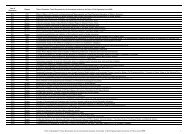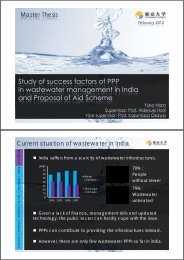Land policy and property price in Hanoi, Vietnam, January 2009
Land policy and property price in Hanoi, Vietnam, January 2009
Land policy and property price in Hanoi, Vietnam, January 2009
Create successful ePaper yourself
Turn your PDF publications into a flip-book with our unique Google optimized e-Paper software.
cooperative ownership. This means that the l<strong>and</strong> was <strong>in</strong> practice either nationalised orconverted <strong>in</strong>to cooperatives follow<strong>in</strong>g <strong>L<strong>and</strong></strong> Reform Law 1953 although the 1960 Constitutiontheoretically allowed the private ownership. After the reunification <strong>in</strong> 1975, the 1980Constitution stipulated that the state has the l<strong>and</strong> ownership for the whole country <strong>and</strong> noprivate right to own the l<strong>and</strong> is allowed. <strong>L<strong>and</strong></strong> was allocated through the central adm<strong>in</strong>istrativecontrol rather than the market mechanism. However, <strong>in</strong> 1988, the State enacted the <strong>L<strong>and</strong></strong> Lawpermitt<strong>in</strong>g the grant of l<strong>and</strong>-use right both to organizations <strong>and</strong> <strong>in</strong>dividuals (GeneralDepartment for <strong>L<strong>and</strong></strong> Adm<strong>in</strong>istration, 2000). The pr<strong>in</strong>ciple of no private right of own<strong>in</strong>g l<strong>and</strong>was changed <strong>in</strong>to “people’s ownership” <strong>and</strong> “state management” <strong>in</strong> the 1992 Constitution <strong>and</strong>1993 <strong>L<strong>and</strong></strong> Law. Furthermore, as a concession to the emerg<strong>in</strong>g mixed market economy, the<strong>L<strong>and</strong></strong> Law 1993 allowed various private rights regard<strong>in</strong>g l<strong>and</strong>, which <strong>in</strong>clude the l<strong>and</strong> transfer<strong>and</strong> leas<strong>in</strong>g without disturb<strong>in</strong>g the underly<strong>in</strong>g pr<strong>in</strong>ciple of state ownership of l<strong>and</strong>. Theserights were extended <strong>and</strong> clarified by the 1998 <strong>and</strong> 2003 <strong>L<strong>and</strong></strong> Laws.2.2.2 <strong>L<strong>and</strong></strong> transfersFormally, private access to urban residential l<strong>and</strong> <strong>in</strong> l<strong>and</strong> market is primarily ga<strong>in</strong>ed not bybuy<strong>in</strong>g <strong>and</strong> sell<strong>in</strong>g but by l<strong>and</strong> transfers (Nguyen <strong>and</strong> Hans, 2002). This is because l<strong>and</strong> is“owned by the people” <strong>in</strong> legislation. 1988 <strong>L<strong>and</strong></strong> Law prohibited any k<strong>in</strong>d of l<strong>and</strong> transaction,encroachment or l<strong>and</strong> lease among private <strong>in</strong>dividuals. The l<strong>and</strong> users, <strong>in</strong> most cases the stateorganizations, were not required to pay for the l<strong>and</strong> allocated to them except for the smallformal amounts of l<strong>and</strong>-use fees. All premises were developed by the state-owned companiesunder the direction of the authorities, thus no <strong>property</strong> market officially existed. However,although the Civil Code (article 694) required the transfer of l<strong>and</strong>-use right to be based on the<strong>price</strong> formula set by the M<strong>in</strong>istry of F<strong>in</strong>ance, <strong>in</strong> practice, both officially registered <strong>and</strong>unregistered l<strong>and</strong> were rout<strong>in</strong>ely bought <strong>and</strong> sold accord<strong>in</strong>g to the market <strong>price</strong>s (GeneralDepartment for <strong>L<strong>and</strong></strong> Adm<strong>in</strong>istration, 2000). Then, 1992 Constitution was <strong>in</strong>troducedrecogniz<strong>in</strong>g that the l<strong>and</strong>-use right can be transferred among households <strong>and</strong> <strong>in</strong>dividualsalthough it restated that all l<strong>and</strong> is owned by the State as representative of the people. Basedon the new pr<strong>in</strong>ciples, a new version of the <strong>L<strong>and</strong></strong> Law was promulgated <strong>in</strong> 1993 mak<strong>in</strong>g asignificant advance toward the formulation of a legal framework for l<strong>and</strong> adm<strong>in</strong>istration. Thenew <strong>L<strong>and</strong></strong> Law established a legal basis for l<strong>and</strong> allocation <strong>and</strong> lease, which secures the l<strong>and</strong>useright of l<strong>and</strong>holders <strong>in</strong>clud<strong>in</strong>g the rights of long-term l<strong>and</strong> use, l<strong>and</strong> transfer, <strong>in</strong>heritance,lease, mortgage, <strong>and</strong> compensation for expropriation. It should be noted that historically,about 70% of all l<strong>and</strong> transactions took place without a paper trail (Phe, 2002). This meansthat the authorities were unable to tax or manage the sector effectively. Thus, the new law alsoaimed to change it by st<strong>and</strong>ardiz<strong>in</strong>g l<strong>and</strong> transactions.2.2.3 <strong>L<strong>and</strong></strong> marketBefore the approval of the <strong>L<strong>and</strong></strong> Law 2003Throughout the socialist period, buy<strong>in</strong>g <strong>and</strong> sell<strong>in</strong>g of urban residential l<strong>and</strong>/hous<strong>in</strong>gcont<strong>in</strong>ued through personal networks <strong>in</strong> the black market under the tacit approval of localauthorities (General Department for <strong>L<strong>and</strong></strong> Adm<strong>in</strong>istration, 2000). The <strong>in</strong>discreet l<strong>and</strong> traderesulted <strong>in</strong> the voluntary surrender of surplus l<strong>and</strong>. Even after the “nationalisation” of privatel<strong>and</strong> <strong>in</strong> 1980, the <strong>in</strong>formal urban hous<strong>in</strong>g market cont<strong>in</strong>ued. The state tacitly accepted thecommoditisation of urban residential, but not commercial l<strong>and</strong>. The state valuated the l<strong>and</strong>useright with the <strong>price</strong> formula. The <strong>price</strong> formulas set by the M<strong>in</strong>istry of F<strong>in</strong>ance are used todeterm<strong>in</strong>e the fees charged for l<strong>and</strong> allotments, leases <strong>and</strong> transfers <strong>and</strong> compensation paid forcompulsory acquisition <strong>and</strong> taxation. In this formula, the values of l<strong>and</strong>-use right aredeterm<strong>in</strong>ed based on city classification group<strong>in</strong>g cities <strong>in</strong>to five classes. The classification is






